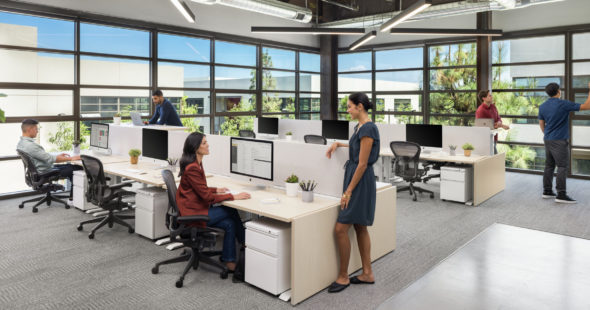The Challenge: Workplace stress is a public health epidemic.
In our “always on” culture, workplace stress is harming employee health, hurting engagement, and costing companies as much as $300 billion per year in lost productivity. Just how widespread is this epidemic?
- 40 percent of employees report their job as “very or extremely stressful”
- 26 percent say they are “often or very stressed out by their work”
- 62 percent end the day with work-related neck pain
- 44 percent experience stressed-out eyes from work
- 34 percent struggle to sleep at night due to workplace stress
Workplace stress is triggered by more than an overflowing in-box or tight project deadline. Scientifically speaking, it’s the perception of having little control but lots of demands. Stress severity depends on the magnitude of the demands and an employee’s sense of control in dealing with these demands. As a result, workplace stress is both a universal and highly personalized phenomenon. For example, the high-pressure deadline that causes one employee to panic could drive another to excel. Conversely, this same employee may feel overwhelmed by a major sales goal or upcoming executive presentation. The result of this stress experience, however, is universal: a fight-or-flight response that’s the opposite of peak performance and productivity.
“When someone is under stress, physiologically they experience a fight or flight response,” says stress management and executive performance consultant Jeffrey Gero. “This response can cause irrational thinking and is the opposite of productivity and peak performance.”
It doesn’t have to be this way in your office, however. The right workplace environment can help combat stress and lead to happier, healthier employees. Here are five ways to get started.
1. Take a midday break, ideally outside.
Stress builds up naturally throughout the day. Without a break, that stress can bubble over and reach a tipping point. Encourage your team to get up and stretch, ideally a couple of times a day. At least once per day, take the break outside to maximize the benefits, whether it’s a short walk or admiring a scenic view.
“In our correlational study among 503 employees, the frequency that employees took a break outside was the strongest predictor of their stress and health,” says Erin Largo-Wight, an associate professor and program director at the Brooks College of Health at the University of North Florida. “All breaks reduced stress, but outdoor breaks were significantly more impactful.”
2. Create space to unwind
An inviting workplace offers dedicated space to relax and disconnect. Depending on your company culture and employee, needs this location could be a game room, a shaded outdoor space with a grill and TV, or a lounge space with a quiet water feature and comfortable, casual furniture. These different environments give employees the chance to reset and reconnect with coworkers outside the traditional office environment.
3. Offer options and set a precedent for use.
Since every employee experiences stress differently, there’s no single activity that helps everyone relax. From midday workout classes to yoga to lounge space to games, offer a variety of options. Doing so empowers employees to make a decision that’s right for them, boosting their sense of autonomy and control, which is key to reducing stress. Most critically, set a precedent for use: when employees see their managers taking a midday break to hit the gym, they’ll also feel comfortable doing so as well.
4. Eliminate environmental stressors
Noise, lighting, and workplace temperature can all affect employee stress levels. Does the physical design of your workplace help reduce those potential stressors, or does it highlight them? Consider the different options employees have for controlling their environment, whether that’s quiet areas for solo work or varying temperatures in individual conference rooms.
5. Lighten up with natural light
Sitting underneath fluorescent lights for long periods can have a detrimental effect on employee health, yet most traditional layouts keep the majority of employee desks in an office’s core where little natural light reaches. Consider how natural light is distributed in your workspace: do your team rooms or shared workspace have access to windows? Are their light shelves that can reflect natural light into the office core? Small changes, like designating an open office with windows as a team space, can elevate mood, boost morale and lower stress.





